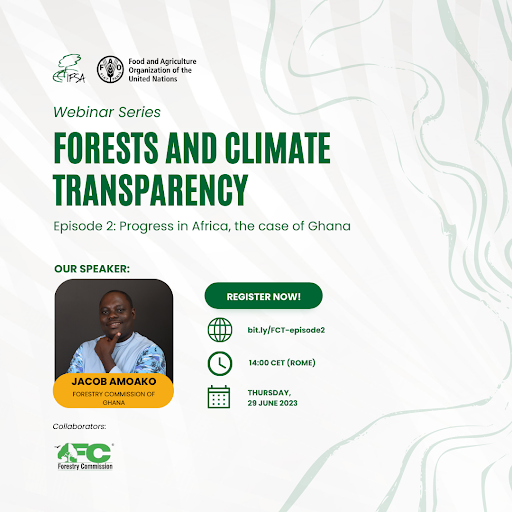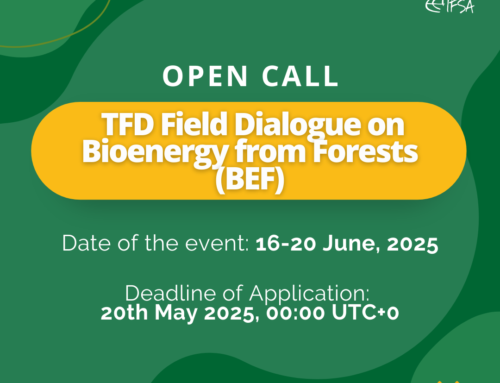“Forests and Climate Transparency
Webinar Series from FAO
Introduction
Countries have made substantial advances in developing and operationalizing their National Forest Monitoring Systems (NFMS) to comply with the measurement, reporting, and verification (MRV) framework under the United Nations Framework Convention on Climate Change (UNFCCC), as well as to provide better forest data to effectively support decision-making and domestic policies, implementing the enhanced transparency framework (ETF) under the Paris Agreement.
At the same time, the need to make the efforts visible and inform young students and professionals about the advances in data transparency and forest inventories is important so that they can take action at the local level and within the UNFCCC process.
For this purpose, the FAO Sub-Commission of IFSA, in collaboration with the FAO Forestry Division (NFO) has organized the “Forest and climate transparency” Webinar Series in which six case studies will be presented, those that are the result of the “Building global capacity to increase transparency in the forest sector (CBIT-Forest)” project, funded by the Capacity Building Initiative for Transparency (CBIT) trust fund of the Global Environment Facility (GEF). The presentation of the case studies will be carried out by representatives of national institutions that were involved in the work carried out in Chile, Costa Rica, the Democratic Republic of the Congo, Ghana, Papua New Guinea, and Bangladesh.
The self-paced course on “Forests and Transparency under the Paris Agreement”, available on FAO’s eLearning Academy, will be promoted through these activities. The webinars will be recorded and available on IFSA’s TreE-Learning platform and IFSA’s youtube channel.
Dates
- First: 19th, April 2023 (Spanish); 3rd May (English)
- Second: 29th of June at 14:00 hrs (UTC+), 2023
- Third: 13th of July at 12:00 hrs (UTC+2), 2023
Episode 2: Progress in Africa, the Case of Ghana

Establishing a multi-purpose national forest monitoring system to improve land use monitoring capacities in Ghana
Ghana has long been implementing REDD+ activities and the country is now designing and implementing an NFMS, with funding from the World Banks’s Forest Carbon Partnership Facility Carbon Fund and UN-REDD. This NFMS acts as a source for land use and forest data, providing information and communication on REDD+ activities, and plays a key role in the management and planning of other related sectors, such as the cocoa sector. Read the full case study here in en, fr & es.
Speakers’ biographies.
-
Jacob Amoako
My career spans over eight years with experience in forestry and natural resource management, climate change mitigation and adaptation program/project development, geographic information system analysis and remote sensing applications, REDD+ implementation, Measurement, reporting, and verification, greenhouse gas accounting, and reporting. Member of the United Nations Framework Convention on Climate Change Roster of Experts contributing to reviews of technical analysis of biennial update reports submitted by non-Annex I Parties and technical assessment sessions of proposed forest reference emission levels and/or forest reference level for REDD+ to the UNFCCC.
I studied Natural resource management (specialization in Silviculture and Forest Management) at the bachelor level at the Kwame Nkrumah University of Science and Technology (KNUST). I continued to Bern University of Applied Sciences for a Master of Science in Applied Agricultural and Forest Sciences in Switzerland and am currently in the final year of a Ph.D. in Climate Change and Landuse at Kwame Nkrumah University of Science and Technology.
Part of the organizing committee for the Northern Africa Regional Meeting of IFSA in 2012 in KNUST-Kumasi, Ghana. Also the resource person for the NARM 2017 at the University of Energy and Natural Resources, Sunyani Ghana. He participated in the IFSA event at the United Nations Forum on Forest 11 in Interlaken, Switzerland, in 2015.
Working with the Forestry Commission of Ghana as the focal point for REDD+ Measurement, Reporting, and Verification since 2016 involved forest reference level establishment and monitoring of performance for REDD+ programs.
Episode 3: Progress in Asia-Pacific, the Case of Papua New Guinea

National Forest monitoring system provides better data and enhances capacity in Papua New Guinea
Previously, Papua New Guinea’s NFMS has been limited by a lack of forest inventory data, resources, and capacity, and limited funding, among other factors. The country has overcome these challenges to successfully submit its forest reference level (FRL) to the UNFCCC, prepare its National REDD+ Strategy, submit its first NDC, and establish a REDD+ and Forest Monitoring Web Portal, all due to NFI and NFMS activities. Read the full case study here in en, fr & es.
Speakers’ biographies.
-
Elizabeth Kaidong
Elizabeth is the acting Climate Change Officer with the REDD+ and Climate Change Branch under the Resource Planning and Development Directorate of the Papua New Guinea (PNG) Forest Authority, with ten years of experience in this role. Elizabeth has been working on climate change activities, mostly REDD+ elements such as NRS, NFMS, FRL, and SIS, with close collaboration with the Climate Change Ministry o PNG. She has a background in forestry, and she was involved in the country’s first Multi-purpose national forest inventory for the country. Elizabeth Kaidong has also been involved in using the Open Foris tools since its inception in Papua New Guinea in updating the forest and land use information.
-
John Pena (PNG Forest Authority, Papua New Guinea)
John has a degree in Forestry from the University of Technology of Papua New Guinea. He is the Senior Forest Plans Officer of the Forest Plans Branch within the Forest Policy and Planning Directorate of the Papua New Guinea Forest Authority (PNGFA). He is also responsible for updating and revising forest plans in PNG at the national (National Forest Plan) and regional (Provincial Forest Plan) levels. He also Assists with Planning the Biomass Survey and National Forest Inventory.
Before his current position, he worked with UN-FAO as the Forest Assessment and Data Management Officer under the National Forest Inventory Project and, before that, the REDD+ Coordinator for the USAID LEAF Project.
Registration Link
Please register in the following link




